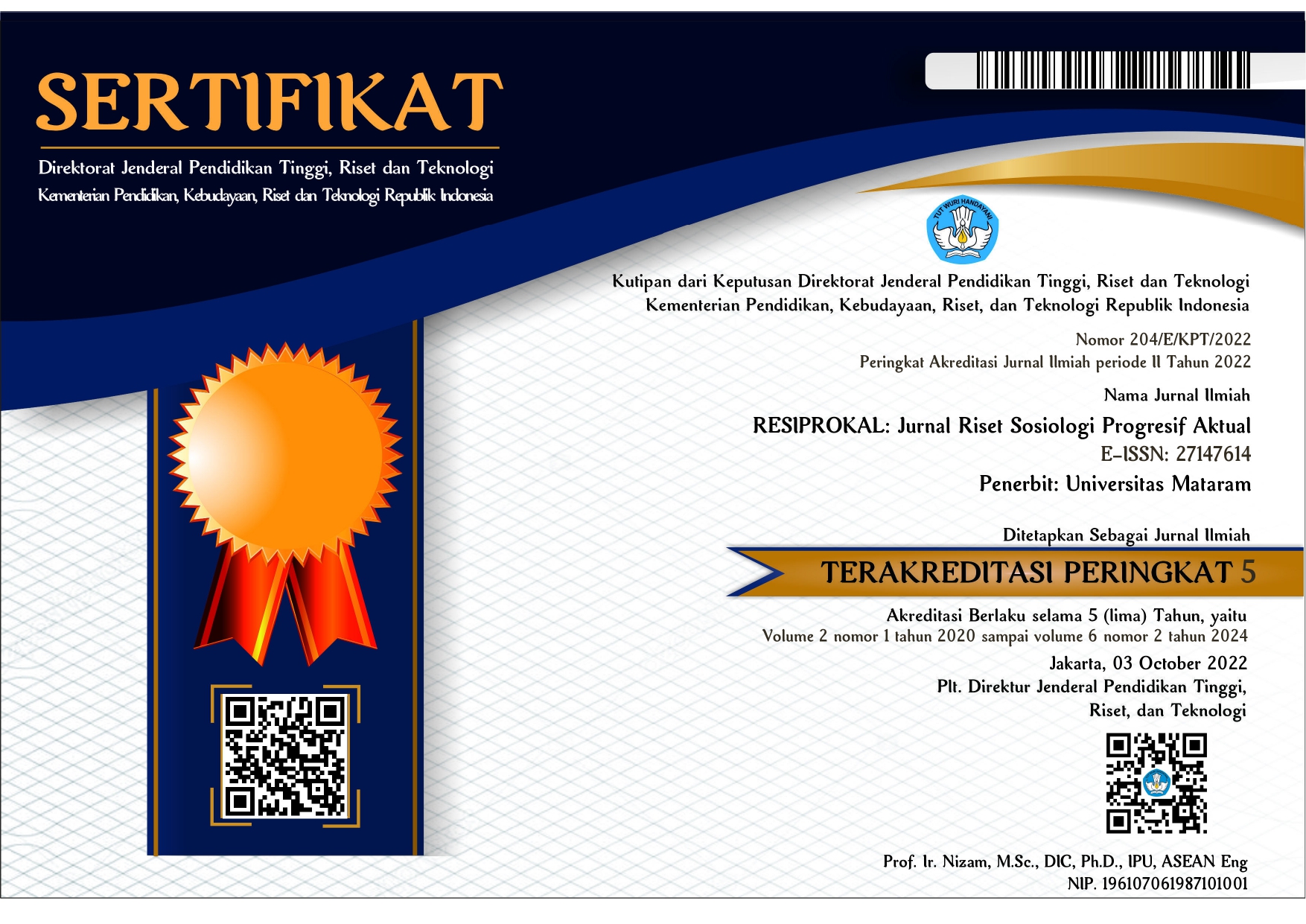Realitas Perilaku Hidup Bersih dan Sehat Pada Masyarakat Yang Tidak Memiliki Jamban Keluarga di Karang Pule, Mataram
DOI:
https://doi.org/10.29303/resiprokal.v4i1.130Keywords:
PHBS Household, Family Laterine, Transform NTBAbstract
Village of Karang Pule has the highest number of people who do not have latrines in City of Mataram. Whereas family latrine facilities are one of the success references in Clean and Healthy Life Behavior (PHBS) in household settings. The purpose of this study was to determine the behavior of clean and healthy living in people who do not have family latrines in Karang Pule, Mataram viewed from the knowledge, attitudes, and actions of the community as well as the factors that influence this behavior. This research was used a qualitative method with a verstehen approach. The results showed that of the ten household PHBS indicators, all informants indicated good knowledge, attitudes, and actions simultaneously on only five PHBS indicators. Environmental aspects are the factors that most influence the implementation of PHBS in the community at home. The conclusions of this study all informants already have the awareness to practice five of the ten PHBS indicators, namely carrying out deliveries by health workers, exclusive breastfeeding, children under five years being weighed every month, doing physical activity every day, and not smoking at home while five indicators. Meanwhile, the other five indicators, namely, using clean water, washing hands with clean water and soap, using latrines, eradicating mosquito larvae, and eating vegetables and fruit every day are still not implemented in households. The factors that influence the implementation of PHBS in the community include social, economic, cultural, and environmental aspects
Downloads
References
1. Miles, M. B., & Huberman, A. M. (1992). Analisis Data Kualitatif. Penerbit Universitas Indonesia (UI-Press).
2. Moleong, L. J. (2007). Metodologi Penelitian Kualitatif. Remaja Karya.
3. Pusat Promosi Kesehatan Depkes RI. (2006). Perilaku Hidup Bersih dan Sehat di Rumah Tangga.
4. Sugiyono. (2019). Metode Penelitian Kuantitatif Kualitatif dan R&D (Sutopo (ed.)). Alfabeta.
5. Wirawan, I. B. (2012). Teori-Teori Sosial dalam Tiga Paradigma (Fakta Sosial, Definisi Sosial, dan Perilaku Sosial). Kencana Prenada Media Group.
JURNAL
6. Elina, Y. (2016). Faktor-Faktor yang Berhubungan dengan Perilaku Hidup Bersih dan Sehat Pada Tatanan Rumah Tangga Menggunakan Jamban Sehat di Dusun II Rw. 04 Desa Sukakarya Kec. Sukakarya Kab. Bekasi Tahun 2016. Jurnal Ilmiah Keperawatan.
7. Gani, H. A., Istiaji, E., & Pratiwi, P. E. (2015). Perilaku Hidup Bersih Dan Sehat (Phbs) Pada Tatanan Rumah Tangga Masyarakat Using (Studi Kualitatif di Desa Kemiren, Kecamatan Glagah, Kabupaten Banyuwangi). Jurnal IKESMA, 11(1), 25–35.
8. Haikal, F. A., Yulyani, V., & Yanti, D. E. (2021). Analisis Faktor Penghambat Kepala Keluarga dalam Kepemilikan Jamban Keluarga. Poltekita: Jurnal Ilmu Kesehatan, 15(1), 31–36
9. Tontuli, E., Paturusi, A., & Mokoagow, A. (2020). Tingkat pengetahuan ibu rumah tangga tentang. Pidemia Jurnal Kesehatan Masyarakat UNIMA, 01(02), 12–17
WEBSITE
10. Daktacom. (2019). Kemenkes: 22 Persen KK di Indonesia Belum Miliki Jamban.Dakta.Com.http://www.dakta.com/news/20946/kemenkes-22-persen-kk-di-indonesia-belum-miliki-jamban
11. Sekretariat STBM Nasional. (n.d.). Monitoring Data STBM. Sekretariat STBM Nasional. Retrieved October 1, 2021, from http://monev.stbm.kemkes.go.id/monev/
12. Dinkes.mataramkota. (2021). Kota Mataram Lulus Verifikasi Pilar I Stbm, Bebas Buang Air Besar Sembaran (BABS). Dinkes.Mataramkota.Go.Id.https://dinkes.mataramkota.go.id/blog/post/kota-mataram-lulus-verifikasi-pilar-i-stbm-bebas-buang-air-besar-sembaran-babs
13. Furqon, M. (2021). Deklarasi Kota Mataram sebagai Kota ODF (Open Defecation Free) “Stop Buang Air Besar Sembarangan.” Mataramkota.Go.Id.https://kim.mataramkota.go.id/deklarasi-kota-mataram-sebagai-kota-odf-open-defecation-free-stop-buang-air-besar-sembarangan/








